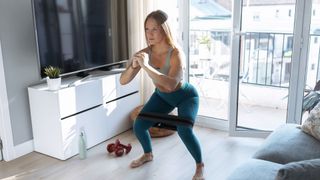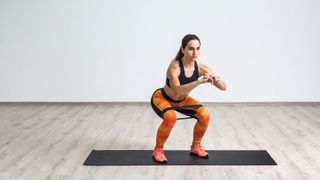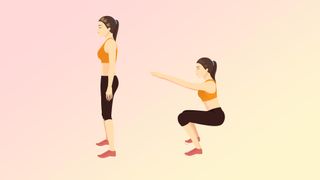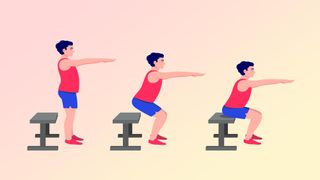This resistance band exercise targets all of the muscles in your legs
Add this resistance band circuit to your next leg day to feel the burn

Performing squats with resistance bands is among the most effective exercises you can do. Not only do resistance band squats work every muscle in the legs, but most of the other major muscle groups in the body will be targeted, too. Your arms and shoulders, for example, work to keep you balanced, and the muscles of your torso and back help keep you upright during the squat.
Bodyweight squats are a brilliant exercise that gets you a lot of bang for your buck, but with a little bit of training, they can quickly become too easy, and you might find you need extra resistance to make things harder. This is where resistance bands come in. Resistance bands are inexpensive, versatile, lightweight, portable, and highly convenient, and we've found the best resistance bands to add to your workouts here.
In this article, we’ll run you through exactly how to do a resistance band squat with the correct form.
Looking for more workout inspiration? We've found six of the best resistance band arm exercises for building your guns without weights, the best ab workouts you can do from just about anywhere, and an exercise that’s better than squats at building your glutes.
What are the benefits of resistance band squats?
Squats provide an amazing leg workout. Because your leg muscles are some of the biggest in your body, they require oxygen and blood in order for them to work hard. As such, your heart and lungs are also getting a workout when you’re doing squats, making squats, and especially squats with resistance bands, a great cardiovascular exercise.
If like millions of other Americans, you find yourself sitting down for most of the day, it's likely you'll suffer from tight hips, back pain, and poor posture. While squats are not a fix-all, they do a tremendous job of opening up the hips and loosening up the lower body. They can also help strengthen your back and improve your posture, as a well-performed squat requires good alignment in your upper body.
Take a look at the best exercises to do if you sit down all day, plus the best exercises for strengthening your lower back here.
Sign up to get the BEST of Tom’s Guide direct to your inbox.
Upgrade your life with a daily dose of the biggest tech news, lifestyle hacks and our curated analysis. Be the first to know about cutting-edge gadgets and the hottest deals.

Squats are also great for your brain health. Research has repeatedly shown that exercise is highly beneficial for cognitive function, but in an interview on BBC’s Just One Thing podcast, Professor Damian Bailey from the University of South Wales said that squats are the best exercise for brain health. According to Dr. Bailey, doing squats "releases the good chemicals that the brain needs to grow to get more intelligent".
How to do resistance band squats
To do a squat, stand with your feet a little further than shoulder-width apart. Imagine you’re standing on a clock-face, and point your toes to 11 o’clock and one o’clock. To start the squat, bend your knees and hips as if you’re sitting on a chair that’s directly beneath you. As you squat down, push your knees outwards so that they track directly over your middle toe.
As you squat lower, push your chest out, and keep your eyes looking straight ahead to keep your back flat and avoid hunching or rounding your spine. Squat down as low as you can while keeping your knees in line with your feet and your back flat, then push with your feet to stand back up to your starting position.

How to do a squat with a small loop resistance band
If you have a small resistance band, loop it around your knees and perform the squat as above. This will work the glute muscles more, and make it harder to keep your knees pointing outwards.

How to do resistance band squats with a long resistance band
With a long resistance band, you can loop the band around your feet so that you’re standing on it, and hold the other end in your hands just below your chin to provide extra resistance. Alternatively, lay the band flat on the floor, stand on it, grab the ends in either hand (like you’re carrying groceries). To make sure you’re squatting correctly, squat in front of a mirror or video yourself on your phone. Make sure your back stays flat, and that your knees are in line with your toes the whole time.
If you’re finding the squats with resistance bands to be too challenging, stick to bodyweight-only squats. You can make bodyweight squats more difficult by slowing the movement down, pausing for a three-second count at the bottom of the movement, increasing the number of reps, or taking less rest between squats or between sets of squats.
How to make squats more challenging
You can mix up the intensity of your squats by changing your stance, using different equipment or incorporating some household items and furniture. Here are a few ideas:
- Bring your stance narrower, and point your toes straight forward to work the front of your legs harder
- Point your toes out slightly further to really target the inner thighs, but make sure you keep pushing your knees out
- Squat with your heels elevated on a 0.5-1 inch solid object and your toes on the floor to help you squat lower
- If you have weights, do a goblet squat, holding the weight under your chin while you squat
- Try a box squat by squatting down to a seat, taking half a second to balance, before standing back up
- Try squat pulses, doing small bounces up and down at the bottom of the squat for ten counts, before standing back up to your starting position. You can also do this with a small loop resistance band, pulsing your knees outward at the bottom of the squat.
A resistance band squat circuit to try on your next leg day
Looking for a resistance band squat circuit to get you started? We've got it. This is a circuit of five exercises. Do 10-15 reps of each exercise, resting for 30-60 seconds between each. After doing one full circuit, take 60-90 seconds rest, and perform the circuit again for a total of three rounds. This should take around 20 minutes.

1. Bodyweight squats
- Squat with just your own bodyweight

2. Resistance band squats
- Use whichever band you have to make the squat harder as outlined in the steps above.

3. Box squats
- Squat to a seat about knee-height, pause for a few seconds, then rise back up to your starting position.
4. Pause squats
- Squat as low as you can, stay at the bottom of the movement for a three-second count before standing back up

5. Resistance band squats
- Do another 10-15 reps of resistance band squats to finish the circuit.
Will McAuley is a London-based Personal Trainer and Nutrition Coach who’s writing has appeared in Men’s Fitness and GQ magazine, covering exercise, nutrition and health. He has a Master’s degree in Strength & Conditioning from Middlesex University in London, is a published scientific author in the Journal of Strength and Conditioning Research, and holds a Bachelor’s degree in Linguistics from Trinity College Dublin.

